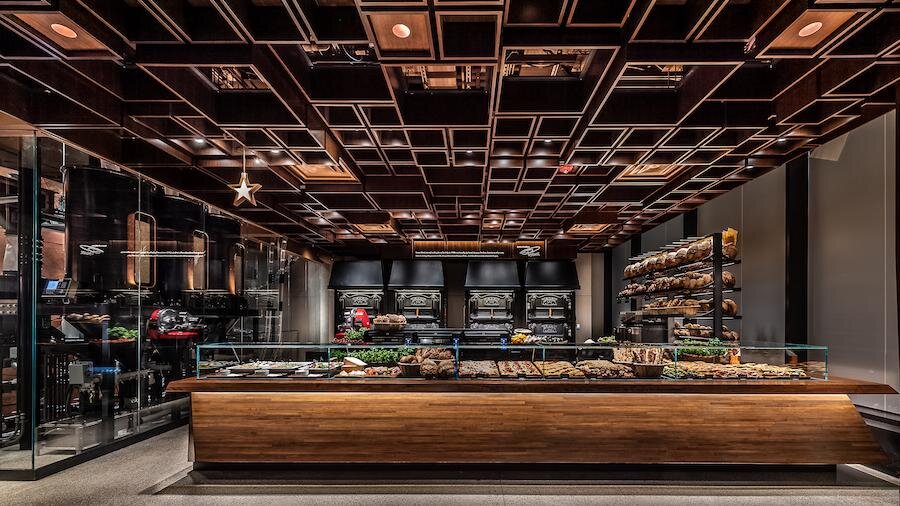Future-proofing the store model
In this article, we dive deeper into how brands can best appropriate their spend and decipher how ‘intangible’ elements of a brand’s identity can be rolled out across store formats and concepts to create clarity of brand, irrespective of size or location of the store.
This article will review:
The ‘spend and execute triangle’
Crafting true hierarchy
Case study: PUMA
The ‘spend and execute triangle’
(Source: Graphic by Ales Kernjak)
When reviewing the process for store openings and creating clear budgets three key areas assist in optimising spend allocation.
Spend per m2 vs retail sales per m2
Expectation of the consumer, relevant to the local market
Location hierarchy in terms of importance to brand
While spend per m2 is calculated by how much money is spent in the total m2 of a store, retail sales per m2 are calculated by the total in-store sales divided by selling area in m2. Staff rooms, offices and warehouses and other areas not directly attributed to sales are excluded from this equation.
Let’s look at an example for spend per m2. Assuming a brand has $1,000,000 to spend on a store with 1,800 m2 floor space, the spend per m2 would be $555 ($1,000,000 / 1,800 m2). The amount brands then spend afterwards on fitting out the store would depend on many other mitigating factors such as the margin of product and cost of store-fit, materials and amount of time CapEx is payable.
(Source: theatrefolk.com)
The second pillar is meeting consumer expectations. Optimal budgets don’t attempt to stretch to build the perfect store in all locations. Therefore, defining and understanding how consumers’ needs vary by location is paramount.
Wants and needs are not the same thing and this can sometimes create confusion for businesses. While need is something that solves an actual or imaginary problem, want is simply something that we’d like to have – with no specific reasoning attached. Consumer expectations can be identified as the anticipated circumstances of a purchase.
A consumer will get out of bed and shop locally because they need something from that store. Whereas a consumer will travel to a major shopping centre because they want more options. This is where the balance of ‘local and global’ can create an inner hierarchy of stores. It’s here the third pillar comes into play – location.
(Source: ecwid.com)
For brands picking out a prime retail space, future-proofing must be built-in. While it can be tempting to pick cheap real-estate for store locations and hope the business generates a steady flow of customers, sometimes there's no substitute for being in the busy part of town. Picking a location centrally might be pricier than an option a few miles away but the differences in footfall can be huge. Within this is the brand halo: the ‘Address Factor’.
Popular cities, neighbourhoods and even streets can add massive credibility to a store.
At the same time, COVID-19 has accelerated a change in consumer habits with more people working from home. With this reduced need to commute, there is currently a big reduction in footfall in city centres. It remains to be seen what effect the pandemic will have once society opens up, but we are confident for physical retail’s triumphant return.
The combination of these three pillars (cost, expectation and location) form a single factor for brands when selecting a store location.
Crafting true hierarchy
(Source: waymarking.com)
There are two overwhelming factors present in the current state of play for rollouts and the creation of stores. (1) Retail has seen a monumental shift towards the internet and store roll-outs on the scale they once were are no longer financially viable. (2) Not only has the global economy not yet fully recovered from the 2008 financial crisis, we are now facing uncertainty on a global scale due to the COVID-19 pandemic, and brands will have to continue to adjust their spending accordingly.
This leaves us in a place where brands are focusing on an ‘all’ and ‘flagship’ model to support both the roll-out and refurbishment of stores. Concept stores can be attributed to the ‘flagship’ category; as many brands utilize the same terminology for both.
The former head creative at Starbucks, Stanley Hainsworth, once stated ‘time and localization were a luxury we didn’t have… when I was there it was seven stores a day and we couldn’t stop the train.’
(Source: arup.com)
Starbucks’ new design philosophy seeks to highlight its long-standing practices such as building strong relationships with farmers, high-quality coffee, and sustainability. They do this by deploying designers unique to each territory to drive a ‘local’ view of the global chain. The designers are also tasked with reinvigorating Starbucks’ role as a ‘third place’ away from home and work where people like to hang out.
Starbucks’ ‘reserve’ concept stores take this one step further, offering both experiential and local attributes, and providing the chance for consumers to step into an immersive, local version of their world. Alongside Starbucks branded Vespas, are sandwiches and bread, affogato freshly made while you wait, coffee bars that don’t offer takeaway as an option, demanding that we stay and enjoy.
(Source: mymodernmet.com)
Case study: PUMA
In 2005, PUMA set about creating a series of marketing initiatives that would enliven visual marketing in their stores to delight, surprise and engage in equal measure – ‘Redworld’. The aim was to spread awareness through ‘word of mouth’ – visual moments that are so joyful you feel compelled to share them. Starting this venture with the ‘lightning cat’ in London’s Carnaby Street, a hologram that ‘slept’ in the windows at night and prowled the upper shelves of the store's walls during the day.
(Source: dandad.org)
Understanding that stores needed a suite of options with consistent branding and execution, no matter the location or size, PUMA further developed the ‘Redworld’ concept.
Giving consumers joy across every store format, and a sense of familiarity, whilst maintaining localised solutions for store design to keep them unique. The Joy-Pad, The Skylite, The Peep Show and The Un-smart Phone were all fun additions to the store landscape that continued the ‘Redworld’ ideals of providing consumer engagement and excitement.
(Source: gbh.london)
The Osaka landmark store was designed as more than a shopping place – as a hub for the brand; designed as the ultimate marketing tool for PUMA partners. A social and cultural meeting point with spaces for events and retail alike. The two main floors of the four-storey building are built with an open roof deck, surrounded by a light façade construction creating an open space for performances and sporting events.
Osaka was bunkered between ‘Redworld’ openings across the globe in what PUMA termed ‘Fortress Cities’ - brands that are critical to the brand in terms of destination, the cities too important to fail.
Amsterdam, London, Munich, Beijing, Paris all launched with localisation designed to entice and engage the consumer.
In Amsterdam, light chandeliers constructed from bike frames, and ‘entrance mirrors’ an incredibly local Amsterdam icon all feature throughout the store space. In London and Munich, the Bavarian Cabin, and London Red Telephone box feature strongly.
Beijing launched with the iconic PUMA Cat as a hanging feature made from suede, an icon in its own right.
While in Paris, customers were allowed to take layers of wallpaper featuring immersive designs by local graffiti artists home with them. Each artist took personal ownership of the space, making the store their own.
The ‘Redworld’ initiative started back in 2005 remains relevant today, PUMA joy echoes across every store format, delighting, and surprising customers no matter the location or size of the store.
The intangible, immeasurable branded touch-points, the moments that connect emotively, moments that act as a destination, the elements that surprise, engage, and delight. This is where store design defines and emulates its ‘sweet spot’ as a living, breathing, connective place to belong and buy.
Ales Kernjak expands on his debut article series ‘Let’s Talk About...’ with ‘The Store of the Future’. A thought-provoking new six-part series exploring the evolution of store design; providing the reader with his insights on the concepts and techniques premium and luxury brands are using today, to stay ahead of the curve tomorrow.
ABOUT THE AUTHOR
With an ever-desirable passion for creativity and ability to deliver results, Ales Kernjak has enabled rich and meaningful consumer engagement for some of the world’s biggest brands including Aesop, PUMA and Timberland. For 25+ years he has honed the ability to portray a brand’s story entwined with his 360° brand experience model; reflective of today’s consumer’s needs and tomorrow’s desire. With expertise in retail brand identity, Ales engages a wide range of disciplines; retail concept development, design and roll-out, visual merchandising, visual marketing, staff training and retail operational guidance.













